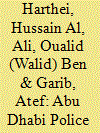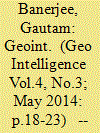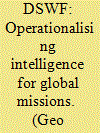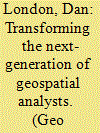|
|
|
Sort Order |
|
|
|
Items / Page
|
|
|
|
|
|
|
| Srl | Item |
| 1 |
ID:
130884


|
|
|
|
|
| Publication |
2014.
|
| Summary/Abstract |
Emergency services such as police vehicles must provide reasonable service levels in order to ensure public safety. These services are typically provided by vehicles based at fixed locations. The number and placement of vehicles generally influences the quality of services offered. Increasing the number of vehicles is often limited by cost constraints; therefore the efficient deployment of such service vehicles is a crucial issue. Emergency service vehicles must be located in such a way that they may reach any demand point within a maximal response time. Current Practices in Abu Dhabi The traffic police in Abu Dhabi perform two major functions: enforcing traffic Abu Dhabi Police Plans laws and assisting road users. Within the Abu Dhabi Police department, the Directorate of Traffic and Patrols, which is in charge of all traffic aspects, allocates the traffic patrol vehicles to routine work and to special operations. The special operations vehicles are involved in escorting convoys and motorcades and in enforcing traffic laws and regulations through the deployment of patrol officers in specific areas at certain times, or in dealing with incidents and special events. The routine patrols perform all remaining tasks. At present, the patrol car allocation process is largely manual and relies heavily on the knowledge, experience and expertise of the dispatch operators. The operators divide the Emirate into geographic zones and allocate patrols based on their knowledge about the areas' needs and other criteria such as traffic flow patterns, population density, etc. In the event of an accident or call for assistance, the dispatcher calls on one of the patrol vehicles nearby and assigns it the task of dealing with the event.
|
|
|
|
|
|
|
|
|
|
|
|
|
|
|
|
| 2 |
ID:
130879


|
|
|
|
|
| Publication |
2014.
|
| Summary/Abstract |
Combat, by its very definition, is an event extra-ordinarily excruciating. It is an ultimate condition that is distinguishable by its phenomenal characteristics which demand, among other undertakings, absolute perfection in marshalling the diverse elements of combat that constitute a military force, for example, troops, firepower, mobility and intelligence. Thus down the ages, 'Great Captains' of war have articulated their strategic intellect to secure victory, irrespective of the bulk of forces, by the best orchestration of the resources under their command. In modern times, developments in 'Information Warfare' have raised the bar of such Terrain intelligence has always been important for winning a battle. In this aricle, the writer advocates establishing a repository of battle-space geographic information called Military Geospatial Intelligence System (MGIS) orchestration to such a high level that it becomes possible to exploit to the hilt the individual capabilities of each element of the military machine. More importantly, it is possible now to seamlessly integrate all such diverse force-elements into one whole system of war-fighting. Military intelligence - terrestrial, strategic and tactical - has always been the most decisive factor in application of combat power as well as an enabling tool for the aforementioned 'best' orchestration of military resources. Within its overall ambit, terrain intelligence - geospatial intelligence in the wider sense as we understand today - has been the pivot of strategic, operational and tactical decision making. In the contemporary period of technological explosion, that pivot has assumed unlimited scope for articulation. At the crosshairs of ever-adversarial forces across terrains of unique descriptions, institution of an efficient mechanism for harnessing the properties of geospatial intelligence - MGIS - must, therefore, be a top priority for India. However, to be really effective, that endeavour has to be tailored to Indian conditions and backed up with indigenous competences; the scope and coverage of GIS as propounded by the lead militaries of the world, USA, China, NATO and Russia, is neither accessible nor sustainable and may not even be necessary in the context of India's technical-industrial-fiscal capacity, and inter alia, her military objectives.
|
|
|
|
|
|
|
|
|
|
|
|
|
|
|
|
| 3 |
ID:
130880


|
|
|
|
|
| Publication |
2014.
|
| Summary/Abstract |
The galloping pace of geospatial technologies is proving to be a great enabler and a training facilitator. The relevance of such technologies is particularly visible in two functional domains in ground-based air-defence training. These include enhancing realism in training and automating the erstwhile manual and archaic procedures which are not only time consuming and inflexible but also far divorced from reality. The article looks at some such technologies in play.
|
|
|
|
|
|
|
|
|
|
|
|
|
|
|
|
| 4 |
ID:
130886


|
|
|
|
|
| Publication |
2014.
|
| Summary/Abstract |
GEOINT 2013* Symposium, organised annually by the United States Geospatial Intelligence Foundation (USGIF), was held at Tampa Convention Centre, Tampa, Florida, from April 14-17, 2014. The symposium, which is renowned for its keynote addresses, educational and training sessions and exhibition, provided an excellent opportunity for networking to the geointelligence community. The conference was originally scheduled to be held in October 2013. However, it had to be postponed due to the unprecedented US federal government shutdown. It was therefore held in April this year, with most of the original agenda intact. The symposium was spread over four days. Day 1, designated as Geoint Foreword, was the symposium's pre-conference session dedicated to innovation, emerging trends and academia. The session was introduced by Dr Darryl Mordock, Vice President Professional Development, USGIF. Dave Snowden, founder and chief scientific officer of the consulting firm Cognitive Edge (not to be confused with Edward Snowden!) delivered the first keynote. He suggested the use of human sensors from ordinary life to create a network. Open source data produced by human geography is valuable, he emphasised. This was followed by selected brief talks, called 'lightening talks', on subjects such as crowd sourced imagery, maritime geoint and race cars. The afternoon was dedicated to talks on subjects such as crowd sourced imagery, interoperability and special ops.
|
|
|
|
|
|
|
|
|
|
|
|
|
|
|
|
| 5 |
ID:
130883


|
|
|
|
|
| Publication |
2014.
|
| Summary/Abstract |
It's been ten years since the 2004 National Defense Authorization Act was signed, officially coining the term 'GEOINT'. Today, GEOINT has become such a focus of national defence that the supply of analysts simply cannot meet the demand for imagery products. Almost every intelligence report requires, or could be enhanced by, some geospatial imagery component. As a result, geospatial intelligence software companies like ours have been hard at work developing full suites of integrated geospatial products capable of being used by any analyst, anywhere, at any time. Rather than transforming, through retraining, all-source analysts into geospatial experts, with the right tools, we can empower these talented and experienced all-source analysts to easily extract their own imagery to complete their intelligence products, freeing up the geospatial imagery experts to focus their attention on processing and exploiting more complex geospatial data. To do this, we set out to develop a lightweight, intuitive Web-based Electronic Light Table that would enable any all-source analyst to easily locate imagery, maps, vectors or text reports so they can build their daily intelligence reports or briefings.
|
|
|
|
|
|
|
|
|
|
|
|
|
|
|
|
|
|
|
|
|